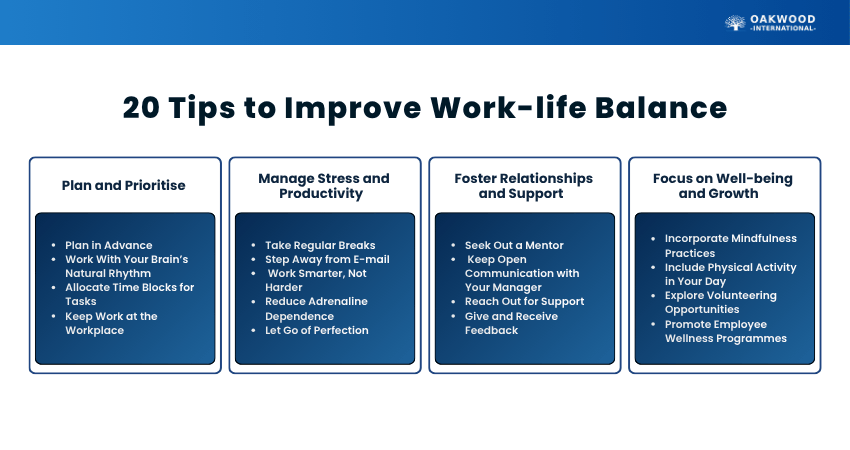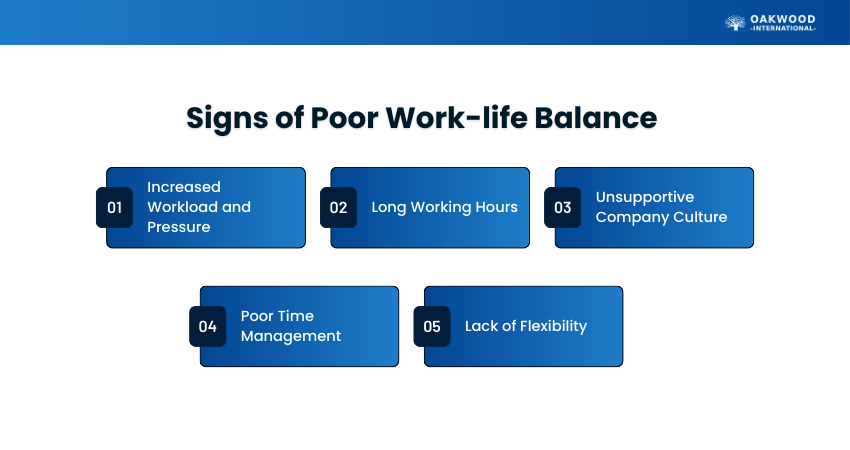Table of Contents


If your life feels like a never-ending loop of work, chores, and caffeine with barely a moment to breathe you’re not alone. Somewhere between morning meetings and midnight emails, we’ve traded balance for burnout. But here’s the truth: Work-life Balance isn’t a myth; it’s a skill you can learn with the right mindset and a few smart changes.
If you are looking for guidance on the same, you’ve come to the right place. This blog delivers 20 practical, achievable tips for Work-life Balance to help you protect your time and reduce stress. These small steps will help you create a healthier rhythm between work and personal well-being, whether by setting boundaries, or taking mindful breaks. So, let’s dive in!
What is Work-life Balance?
Work-life balance refers to creating a healthy relationship between your professional responsibilities and personal life. It means managing your time and energy intentionally so you can meet work commitments while still prioritising rest, self-care, and overall well-being.
Ideally, once the workday ends, you have space to enjoy activities that fulfil and recharge you, such as spending time with loved ones or pursuing hobbies. Since everyone’s lifestyle and priorities can vary, a healthy balance will look unique for each person. What matters most is finding a rhythm that supports your individual goals, needs and personal well-being.
20 Tips to Improve Work-life Balance
A) Plan and Prioritise
Finding a balance between your job and personal life means having enough time for both without feeling constantly stressed or worn out. These 20 tips for maintaining a Healthy Work-life Balance will help you stay productive at work while enjoying more peace, rest, and happiness at home.
Whether you're working in an office or remotely, small changes like these can make a big difference in how you feel and function each day. These Work-life Balance tips are designed to help you feel more in control. When your life is in balance, your energy, mood, and productivity naturally improve creating space for the things that truly matter.
1) Plan in Advance
Start your week with a clear plan. Write down what needs to be done each day and mark the most important tasks. Planning ahead helps reduce stress and keeps you focused.
Example: On Sunday evening, list your key tasks for the week like team meetings on Tuesday or report deadlines on Friday and assign one or two goals for each day.
2) Work With Your Brain’s Natural Rhythm
Pay attention to when you feel most focused during the day. Use those hours for difficult work and save easier tasks for low-energy periods.
Example: If you’re sharpest from 9 AM to 11 AM, use that time to analyse data or write reports, and leave admin tasks like filing or email for later.
3) Allocate Time Blocks for Tasks
Split your day into focused time blocks. Each block is for one task only. This prevents multitasking and improves concentration.
Example: Block out 10 AM to 12 PM just for client calls, with no interruptions. Then, dedicate 1 PM to 2 PM for replying to emails.
Empower your leadership with proven employee relations skills. Join our Employee Relations Training today!
4) Keep Work at the Workplace
Once the workday ends, switch off fully. Don’t let it spill into your personal time. This helps to keep work at the workplace for making space for quality personal time.
Example: Shut down your laptop at 6 PM and turn off work notifications on your phone to enjoy dinner with your family without interruptions.
B) Manage Stress and Productivity
5) Take Regular Breaks
Short breaks give your brain time to recharge and improve focus. Aim for one break every hour.
Example: Work for 50 minutes, then take a 10-minute walk around your home or office. It boosts blood flow and helps reset your attention.
6) Step Away from E-mail
Constant email checks reduce focus. Instead, limit email checks to a few times a day to stay more focused on your work.
Example: Turn off notifications and check emails at 10 AM, 2 PM, and 4 PM. Outside those times, focus on other tasks without distractions.
7) Work Smarter, Not Harder
Find easier ways to complete your tasks. Use tools or streamline your methods to make the work more manageable.
Example: Use Excel formulas to automate calculations or install a browser extension to schedule social media posts in advance.
8) Reduce Adrenaline Dependence
Don’t wait for last-minute pressure to get things done. Work at a steady pace. This will keep you focused, calm and in control.
Example: Instead of writing a presentation the night before, draft it early in the week and revise slowly over the next few days.
9) Let Go of Perfection
You don’t need to do everything perfectly. Aim for excellence, not perfection. Letting go of perfection and embracing progress, makes you work with confidence.
Example: : Submit a report that’s 95% polished instead of spending hours on tiny edits that don’t add much value.
C) Foster Relationships and Support
10) Seek Out a Mentor
A mentor can instruct you through career challenges and offer support based on experience..
Example: If you’re not sure how to handle a difficult client, a mentor can share how they’ve deal with similar situations and give you new ideas.
11) Keep Open Communication with Your Manager
Let your manager know if you’re feeling overwhelmed. Being honest helps them support you better.
Example: Say, “I’m finding it hard to meet both deadlines this week. Can we adjust the timeline or reprioritise?” This starts a helpful discussion.
12) Reach Out for Support
Don’t try to manage everything alone. Ask for help when you need it. It is a sign of strength and helps you be focused and emotionally healthy.
Example: If you’re feeling down or stuck, call a friend or book a session with a counsellor to talk through what’s bothering you.
13) Give and Receive Feedback
Sharing feedback builds stronger teams and helps you grow. When you give feedback, you support others growth and when you receive it, you learn new ways of working better
Example: After a team project, thank your colleague for their support and ask, “Is there anything I could improve for next time?”

D) Focus on Well-being and Growth
14) Incorporate Mindfulness Practices
Mindfulness helps lower stress. Even a few minutes a day can improve focus and calm. This will enhance your sense of presence in daily life and maintain Work-life Balance.
Example: Take 5 minutes in the morning to sit quietly and breathe deeply or use a mindfulness app like Headspace during lunch.
Transform your HR vision into a powerful business strategy. Join our HR Strategy Training now!
15) Include Physical Activity in Your Day
Exercise boosts both mental and physical energy, and even short activities can help. This will keep you more focused, joyous and healthier.
Example: Do 10 minutes of stretching after lunch, take a short walk while on a call, or do jumping jacks between meetings.
16) Explore Volunteering Opportunities
Volunteering adds purpose and connects you with your community. It helps people in need and boosts your purpose and happiness levels leading to a health Work-life Balance.
Example: Join a local clean-up drive on weekends or help at a food bank once a month to give back and feel fulfilled.
17) Promote Employee Wellness Programmes
Wellness programmes improve health and morale. Take part when available. Through participation, you will stay active, reduce stress and build positive habits.
Example: Sign up for your workplace’s yoga class or health talk or ask HR about flexible working hours during stressful periods.
E) Build Long-term Balance
18) Build Flexibility into Schedules
Leave gaps in your schedule for unexpected changes. Flexibility prevents burnout when things shift. This helps to foster healthy Work-life Balance.
Example: If your meeting finishes early, use the extra 15 minutes for a break instead of diving into another task immediately.
19) Create Your Own Guidelines
Make rules that protect your time and focus. Stick to them daily. This will keep you disciplined, avoid burnout and maintain boundaries, thus contributing to better Work-life Balance.
Example: Decide not to check work messages after 8 PM or take meetings during your lunch hour and let your team know these boundaries.
20) Enhance Time Management Skills
Use lists and planners to organise your tasks and avoid timewasters by following Time Management Tips.
Example: Use the Pomodoro technique for 25 minutes of focused work followed by a 5-minute break, and track your progress using a timer app.

1) Signs of Poor Work-life Balance
Some key indicators or signs of poor Work-life Balance are:

2) Long Working Hours:
Spending more time at work than intended reduces the opportunities to connect with loved ones or enjoy fulfilling personal activities outside the workplace.
3) Unsupportive Company Culture:
There are times when workplace cultures can create pressure on employees to work extended hours and devote the majority of their time to work. This constant expectation can predictably lead to stress and a decline in overall well-being.
4) Poor Time Management:
Struggling to organise time can cause tasks to spill over. This can leave little room to manage personal priorities or recharge. Time Management skills are key to a better Work-life Balance.
5) Lack of Flexibility:
When employees have limited flexibility such as no option for remote work or difficulty adjusting schedules for personal matters, their ability to maintain a healthy Work-life Balance can be impacted.
Conclusion
Achieving a healthy Work-life Balance doesn’t require major life changes. It starts with small, intentional steps. By setting boundaries, managing your time wisely, and caring for your well-being, you can reduce stress and enjoy more fulfilment. Use these tips to take control of your day and build a healthier rhythm between your personal life and professional responsibilities.
Bridge the gap between leadership and HR essentials. Join our HR Skills for Non-HR Managers Training now!


 Back
Back



 Back to Catagories
Back to Catagories





 + 44 7452 122728
+ 44 7452 122728










